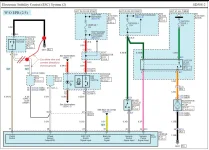The power "dip" at clutch engagement has been an annoyance to me ever since I got my G70 6MT in March. I pride myself on being able to give my passengers (usually my wife and kids) a smooth ride no matter what car I'm driving, but especially in a manual. Maybe with more time I would be able to perfect the clutch/throttle movements to deal with the dip, but after 1500 miles I was still getting a jerky ride while trying to drive relaxed and smooth.
As an experiment, I bypassed the clutch switch so the ECM always thinks the clutch is engaged. The result is pretty incredible: NO DIP! I've been driving with it this way for a week and I'm still getting used to the smooth clutch release; I keep expecting the jerkiness that I've been so disappointed with. Slow, relaxed driving is much smoother now. I also notice that when feathering the clutch as I turn up a slight incline into my garage, the engine doesn't want to die as easily if I don't give it any gas.
I like my car to always feel and drive the same way no matter what I'm doing. Being able to adjust the steering and throttle response with the drive mode switch is great, but once I've found my preferred settings, I want to keep it that way. I used to always drive in Sport mode because, as others have mentioned, the dip is less pronounced in that mode. It was an inconvenience to have to switch to Sport mode every time I started the car. Now I'm finally able to drive in the default Comfort mode without the dip. The steering is less twitchy in Comfort, which I like, but I had gotten used to the throttle calibration in Sport mode. So I've installed a BMS pedal tuner to increase the sensitivity of the throttle in Comfort mode. Now I've found that I prefer the pedal tuner set near its lowest setting for smooth driving, so my throttle is probably not quite as sensitive as the stock Sport mode.
This modification is not without any downsides; there are two side effects that I've noticed. The description of the clutch switch in the service manual states that the "signal enables ECM to cope with instant change of load condition." The first side effect is extra rev hang between upshifts. The ECM normally lets the revs fall when the clutch is disengaged. When it doesn't know that you've pressed in the clutch pedal, there is a longer delay before the revs fall. I have to say I really don't mind the rev hang. I find that when I'm driving relaxed and shifting slowly, sometimes the revs would fall a little too much. Now they might stay a little too high, but a slightly slower release of the clutch pedal after shifting takes care of that. And when driving aggressively and shifting fast, the rev hang seems to give me a little head start as I get on the throttle in the next gear.
The second side effect is the inability of the engine to rev freely when blipping the throttle for a downshift. Since the ECM still thinks the engine is under load, it revs much more slowly than it normally would with the clutch pedal pushed in. I've found that if I jab the throttle all the way to the floor, I can get just enough increase in engine speed for a smooth downshift. When trying to downshift very quickly, the revs probably won't climb quite high enough for a perfectly smooth shift. I'm still testing this aspect of the modification and haven't had the car in all driving conditions, such as a twisty mountain road.
These two side effects definitely take some getting used to, in a similar way that driving with the dip requires some different technique. I'm going to keep testing the car this way, and if I can get used to the side effects, I plan to keep this modification permanently. I wanted to share this as something people can try if they just can't get used to that power dip after clutch engagement. It does require a little wiring harness surgery that some people might not be comfortable with, but it can be put back the way it was pretty easily.











